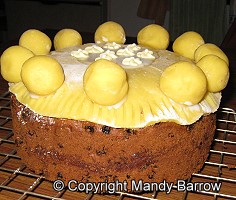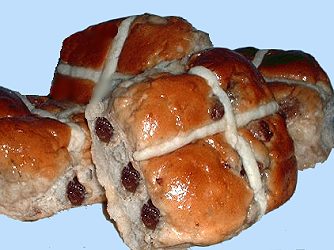EASTER CUSTOMS IN GREAT BRITAIN
WHAT IS EASTER?
Easter is the time for holidays, festivals and a time for giving chocolate Easter eggs. But Easter means much more....
Easter is the oldest and the most important Christian Festival, the celebration of the death and coming to life again of Jesus Christ. For Christians, the dawn of Easter Sunday with its message of new life is the high point of the Christian year.
WHAT IS THE EASTER STORY?
Easter is the story of Jesus' last days in Jerusalem before his death. The Easter story includes Maundy Thursday (the Last supper leading to the Eucharist), Good Friday (the day on which Jesus was crucified) and Easter Day (the day on which Jesus came back to life).
It is a sad story because Jesus was killed. But the story has a very happy ending, because Jesus came back to life and visited his friends and followers once more. He did not die at all, but went back up to Heaven to be with God his father.
WHAT FOODS ARE TRADITIONALLY EATEN AT EASTER TIME?
GOOD FRIDAY
Hot Cross Buns are traditionally served on Good Friday.
A Hot Cross Bun is rich, spiced tea cake.

EASTER DAY
Boiled eggs are traditionally served at breakfast.
Roast lamb, which is the main dish at Jewish Passover, is the traditional meat for the main meal on Easter Day.
Simnel cake is baked for tea.

Easter Traditions In England
- As a part of Easter tradition, there is a trend among British people to eat yummy hams, in order to commemorate the Easter Sunday.
- In England, special springtime dance troupes are called upon, to give exclusive Morris dance performances. This trend of holding dances is not new, rather it is a century old tradition.
- Morris Dance is the biggest attraction of Easter jubilation in England. This dance is always staged by professional male troupes who observe old spring dances to frighten away the evil spirits of winter. The attire of the dancers is extremely traditional wherein they wear white shorts, red sashes, black trousers and straw hats. Red and green ribbons along with flowers and streamers are also added to their attire to make their look all the more colorful.
- In a small town of England called Olney, the tradition is of conducting pancake race on every Shrove Tuesday. It is an event that is celebrated on a large scale and people have a real gala time enjoying this unique day also addressed as Pancake Tuesday.
- Churches are beautifully decorated with different color flowers. White lilies are placed on the altar and these gorgeous flowers are also displayed on the graveyard.
- For offering prayers in the church, men and women dress up in their special outfits and as a part of their wardrobe, colorful Easter bonnets embellished with flowers is like a must.
- Special Easter parades are held in Britain and the parade conducted at Battersea Park in London is a very popular one.
- The Easter celebrations commences with great zeal and vigor before the Palm Sunday. According to the legends, on this particular day Jesus Christ had arrived in Jerusalem and had been welcomed by the city by laying a carpet of Palm leaves and waving Palm branches. This custom is still observed in UK even and on the day of Easter, the entire city parades on the city streets with people carrying palm branches.
- Special Easter parades are held in Britain and the parade conducted at Battersea Park in London is a very popular one.
Easter Traditions in Ireland
One of the most important religious dates in the Irish calendar, apart from St Patrick’s day, is Easter as we celebrate the resurrection of Jesus and also holds a number of different Irish traditions.
In Ireland preparation for Easter usually starts on the first day of Lent, forty days before Easter Sunday. From the first day of Lent Irish people would stop eating meat but would also quit something they cherish such as favorite food, alcohol, cigarettes and even television.
During the forty days of Lent fish would be eaten each Friday which is usually cooked in a soup. It’s a time of self discipline and a reflection on what Irish people have to be thankful for but also a time for Irish families to be together.
Easter Traditions in Scotland
One of the major festivals of the Christian community is Easter. It is time to get religious. The festival that marks the passion, death, and resurrection of Jesus Christ is observed throughout the world with solemnity. Distinct customs and rituals are followed in different countries that celebrate the festival. Easter traditions in Scotland include the age-old custom of painting on an egg and rolling it down the hill and lighting up huge fires. These also follow other conventional approaches of egg hunt and decoration contests.
Easter Traditions in Wales
Wales is proud to have its own Easter traditions which stretch back centuries. Its Easter celebrations start on Suly Blodau (Sunday of Flowers) or as it's more commonly know Palm Sunday. On this day it is customary to decorate the graves in churchyards with beautiful floral arrangements in readiness for Easter and the festival of the Resurrection. Before the graves are decorated they are often cleaned, weeded and even whitewashed before garlands of daffodils, rosemary, rue, primroses and crocuses and placed.
Y Groglith is Welsh for Good Friday and has a number of customs associated with it. One of the most well known is one which occurs in Tenby along the Pembrokeshire coast. On this day all business with in the town was suspended with even horse and carts stopped and not a person to been seen on the streets anywhere. People would then walk barefoot to the church in order not to disturb the earth, Jesus' burial place. There was also a custom of "making Christ's bed" which saw long reeds gathered from the river and woven to gather by the children of the town. The children would use the reeds to create the figure of a man and then laid them upon wood crosses and leave them in quite fields to rest in peace.
Llun y Pasg is Welsh for Easter Monday. As with many customs and rituals in Wales the hills and mountains play an integral part and Easter Monday celebrations are no exceptions. The festivities start earlier on Easter Monday with a procession to the top of nearby mountains before the sun has even risen. Crowds then watch the sunrise in honour of the resurrection. Some areas of Wales are known to carry bowls of water to the summit in order to reflect the rising sun while some very energetic people were said to have performed three somersaults as the sun rises.
LINKS
http://projectbritain.com/easter.html#what
http://ezinearticles.com/?Easter-Traditions-in-Wales&id=3727800
http://www.flightshotelstours.com/easter/traditions/scotland.html
http://www.yourirish.com/easter-in-ireland
http://www.indobase.com/holidays/easter/easter-traditions-around-the-world/easter-in-uk.html